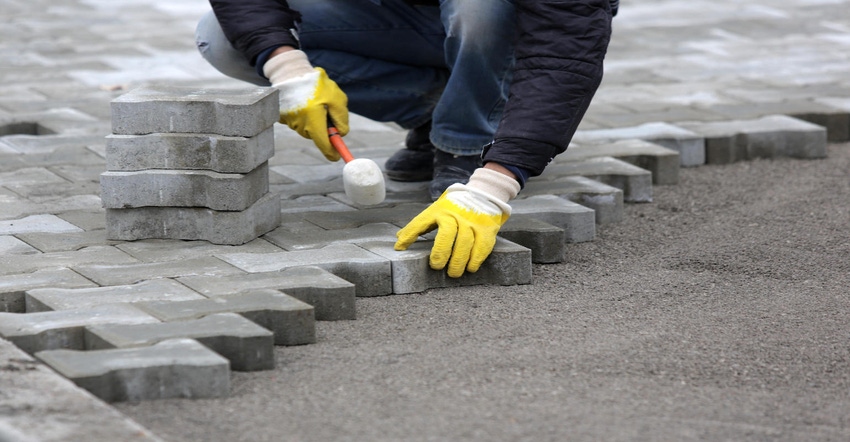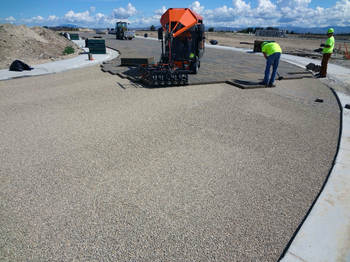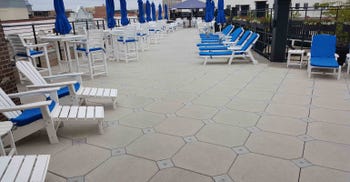Demand for Concrete Pavers, Paving Slabs On the Rise
The use of paving systems is growing in residential applications. That's according to experts at the Interlocking Concrete Pavement Institute, who explained new trends including the use of pavement slabs for roof decks.
June 1, 2022

Demand for concerte pavers continues to grow at a pace not seen in over 15 years as homeowners take advantage of economic conditions that have encouraged home-improvement projects.
That's according to experts at the Interlocking Concrete Pavement Institute (ICPI), based in Chantilly, Virginia, which has been representing the paver industry in the United States and Canada since 1994. ICPI's mission is to promote segmental concrete pavement products and systems for municipal, commercial and residential applications.
“We represent about 75 percent of the production and have about 1,000 members, 800 being contractors and the rest are manufacturers and those who supply industry with cement, equipment, and other essentials,” said ICPI Technical Director David R. Smith. “Our bread-and-butter is providing information for designers and contractors on design, construction, and maintenance of various segmental concrete pavement systems. We have the largest concrete paver producers and independents in the industry as members. We're very aware of where the markets and technology are going.”
Demand for pavers is on the rise
The use of paving systems is growing in residential applications.
“About 80 percent of all the products made are sold to (residential applications),�” said Smith. “COVID presented a silver lining because with the lockdowns, and post-lockdown period, people cut out spending money on vacations. The need for home improvements skyrocketed around May of 2020 and the manufacturing and construction sides of the industry have been overwhelmed ever since. They are working overtime to meet demand. This may start to cool off in the fall, but with low-interest rates and rising housing prices, there is equity available for homeowners to make improvements.”
The ICPI surveys contractors annually and found that between 2020 and 2021, there was a 27 percent average growth in sales. The awareness and use of concrete pavers, paving slabs, and permeable interlocking concrete pavement continues to grow.
“People wanted better places and outdoor spaces, and the cost of creating a patio, outdoor kitchen, or other amenities provided a sense of security and friendship,” he added. “We haven’t seen this sales pace since 2006. All manufacturing numbers exceeded that peak and now factories are running 24/7, six-and-a-half days a week. Our members are doing a great job developing and enhancing catalogs and websites to further reach the residential market. Like much of the construction industry with labor shortages, paver contractors are booked a year or more out, even to do the simplest projects.”
 Permeable interlocking concrete pavement (PICP) demand also growing
Permeable interlocking concrete pavement (PICP) demand also growing
“Permeable pavement does a really good job of reducing stormwater runoff,” said Smith. “It’s a pavement with pavers spaced a little further apart than regular interlocking pavement, and instead of using sand in the joints, they are filled with stone graded to allow water to pass through it quickly. Underneath the pavers are succeeding layers of open-graded aggregates which have a water storage capacity of 35 to 40 percent.”
This runoff storage and infiltration system is a reaction to regulations to reduce stormwater runoff pollution passed in the U.S. in 2000.
“A national permit system for discharging stormwater runoff emerged from these regulations and the Environmental Protection Agency promoted permeable pavements,” said Smith. “Practically overnight, the EPA put up a website that explained PICP that could be used to reduce runoff pollutants to help meet permit requirements. We instantly received national awareness of PICP, especially among state and local governments who were charged by EPA to administer the permits.
“That was a small miracle,” he added. “PICP is maybe five to ten percent of the product sales within the industry. We’re seeing a consistent increase in the use of these pavements."
Older American cities have combined sewers meaning stormwater and sanitary sewage flowing in the same pipe toward a wastewater treatment plant. Many of these cities are using PICP to reduce the volumes of water that can’t be treated by these treatment plants.
There were hundreds of court cases pending and this led to court orders called ‘consent decrees’ that required municipalities to reduce the rate and amount of stormwater entering sanitary sewers. The requirements included converting the surface of the land from impermeable to permeable pavements including PICP. This conversion will take decades, but progress is being made. A recent example is the City of Atlanta installing about four miles of PICP in residential neighborhoods just south of its downtown where combined sewers came together.
“After a big rainstorm in 2012 that caused combined sewer overflows, a lot of stinky material got on the streets,” said Smith. “Atlanta spent $66 million to reduce combined sewer overflows and flooding with PICP. We’re starting to see other cities undertake similar projects. This technology is going to solve many environmental problems. PICP is a niche pavement system and a bit more expensive compared to competing permeable pavements. However, unlike competing systems, we have one that’s very durable and can be installed and repaired in just about any weather.”
 The use of paving slabs is increasing
The use of paving slabs is increasing
“The difference between an interlocking paver and a slab is that you can pick up a paver with one hand and a slab takes at least two hands,” said Smith. “There’s a need for more visually calmer spaces and one foot by one foot or larger slabs create that character. Landscape architects are moving more towards paving slabs, which is great. Our manufacturers have developed all kinds of really cool finishes – polishing them, putting in different colored aggregates and pigments to get diverse effects, and even hammering them to make them look like stone or by roughing the edges.”
Concrete slabs are also being used on roofs to create outside space for a fraction of the cost of creating ground-level spaces. This is popular with developers in areas where land values are high.
The result is outdoor living space without the cost of acquiring additional land.
“In urbanized areas and big cities like Toronto, New York, and Los Angeles there are tons of roofs – new and old – that can take the weight of pedestal-set paving slabs," said Smith. "These paving slabs are usually 16 by 16 or 24 by 24 inches set on sturdy plastic pedestals, which are typically six or eight inches off the waterproof roof membranes.”
About the Author(s)
You May Also Like


